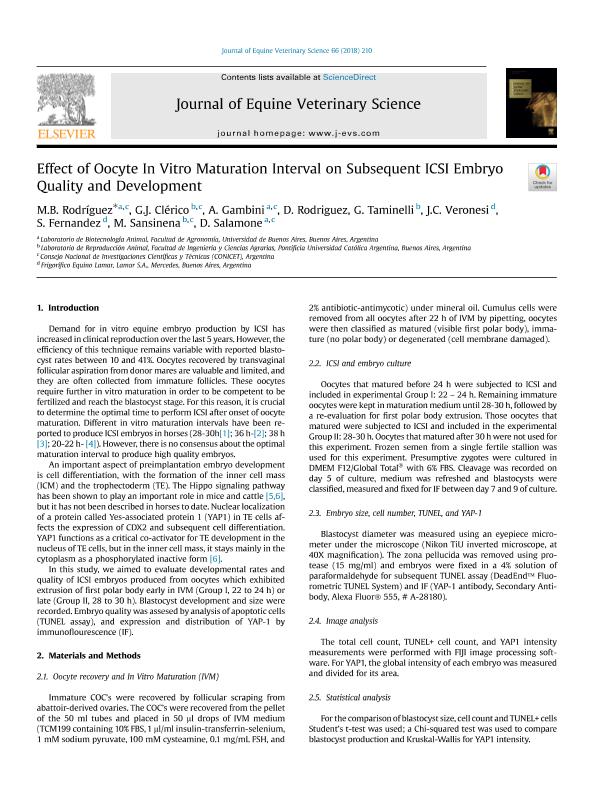Mostrar el registro sencillo del ítem
dc.contributor.author
Rodríguez, M. B.
dc.contributor.author
Clérico, Gabriel José

dc.contributor.author
Gambini, Andres

dc.contributor.author
Rodriguez, Delfina
dc.contributor.author
Taminelli, Guillermo Luis

dc.contributor.author
Veronesi, J. C.
dc.contributor.author
Fernandez, S.
dc.contributor.author
Sansinena, Marina Julia

dc.contributor.author
Salamone, Daniel Felipe

dc.date.available
2023-08-08T13:01:22Z
dc.date.issued
2018-07
dc.identifier.citation
Rodríguez, M. B.; Clérico, Gabriel José; Gambini, Andres; Rodriguez, Delfina; Taminelli, Guillermo Luis; et al.; Effect of Oocyte In Vitro Maturation Interval on Subsequent ICSI Embryo Quality and Development; Elsevier Science Inc.; Journal of Equine Veterinary Science; 66; 7-2018; 210-211
dc.identifier.issn
0737-0806
dc.identifier.uri
http://hdl.handle.net/11336/207318
dc.description.abstract
Demand for in vitro equine embryo production by ICSI hasincreased in clinical reproduction over the last 5 years. However, theefficiency of this technique remains variable with reported blastocyst rates between 10 and 41%. Oocytes recovered by transvaginalfollicular aspiration from donor mares are valuable and limited, andthey are often collected from immature follicles. These oocytesrequire further in vitro maturation in order to be competent to befertilized and reach the blastocyst stage. For this reason, it is crucialto determine the optimal time to perform ICSI after onset of oocytematuration. Different in vitro maturation intervals have been reported to produce ICSI embryos in horses (28-30h[1]; 36 h-[2]; 38 h[3]; 20-22 h- [4]). However, there is no consensus about the optimalmaturation interval to produce high quality embryos.An important aspect of preimplantation embryo developmentis cell differentiation, with the formation of the inner cell mass(ICM) and the trophectoderm (TE). The Hippo signaling pathwayhas been shown to play an important role in mice and cattle [5,6],but it has not been described in horses to date. Nuclear localizationof a protein called Yes-associated protein 1 (YAP1) in TE cells affects the expression of CDX2 and subsequent cell differentiation.YAP1 functions as a critical co-activator for TE development in thenucleus of TE cells, but in the inner cell mass, it stays mainly in thecytoplasm as a phosphorylated inactive form [6].In this study, we aimed to evaluate developmental rates andquality of ICSI embryos produced from oocytes which exhibitedextrusion of first polar body early in IVM (Group I, 22 to 24 h) orlate (Group II, 28 to 30 h). Blastocyst development and size wererecorded. Embryo quality was assesed by analysis of apoptotic cells(TUNEL assay), and expression and distribution of YAP-1 byimmunoflourescence (IF).
dc.format
application/pdf
dc.language.iso
eng
dc.publisher
Elsevier Science Inc.

dc.rights
info:eu-repo/semantics/openAccess
dc.rights.uri
https://creativecommons.org/licenses/by-nc-sa/2.5/ar/
dc.subject
EQUINE
dc.subject
EMBRYO
dc.subject
ICSI
dc.subject
MATURATION
dc.subject.classification
Otras Ciencias Veterinarias

dc.subject.classification
Ciencias Veterinarias

dc.subject.classification
CIENCIAS AGRÍCOLAS

dc.title
Effect of Oocyte In Vitro Maturation Interval on Subsequent ICSI Embryo Quality and Development
dc.type
info:eu-repo/semantics/article
dc.type
info:ar-repo/semantics/artículo
dc.type
info:eu-repo/semantics/publishedVersion
dc.date.updated
2023-08-03T17:50:34Z
dc.journal.volume
66
dc.journal.pagination
210-211
dc.journal.pais
Estados Unidos

dc.description.fil
Fil: Rodríguez, M. B.. Universidad de Buenos Aires. Facultad de Agronomía. Pabellón de Zootecnica. Laboratorio de Biotecnología Animal; Argentina
dc.description.fil
Fil: Clérico, Gabriel José. Pontificia Universidad Católica Argentina "Santa María de los Buenos Aires". Facultad de Ciencias Agrarias; Argentina. Consejo Nacional de Investigaciones Científicas y Técnicas; Argentina
dc.description.fil
Fil: Gambini, Andres. Universidad de Buenos Aires. Facultad de Agronomía. Pabellón de Zootecnica. Laboratorio de Biotecnología Animal; Argentina. Consejo Nacional de Investigaciones Científicas y Técnicas; Argentina
dc.description.fil
Fil: Rodriguez, Delfina. Universidad de Buenos Aires. Facultad de Agronomía; Argentina
dc.description.fil
Fil: Taminelli, Guillermo Luis. Pontificia Universidad Católica Argentina "Santa María de los Buenos Aires". Facultad de Ciencias Agrarias; Argentina
dc.description.fil
Fil: Veronesi, J. C.. No especifíca;
dc.description.fil
Fil: Fernandez, S.. No especifíca;
dc.description.fil
Fil: Sansinena, Marina Julia. Pontificia Universidad Católica Argentina "Santa María de los Buenos Aires". Facultad de Ciencias Agrarias; Argentina. Consejo Nacional de Investigaciones Científicas y Técnicas; Argentina
dc.description.fil
Fil: Salamone, Daniel Felipe. Universidad de Buenos Aires. Facultad de Agronomía; Argentina. Consejo Nacional de Investigaciones Científicas y Técnicas; Argentina
dc.journal.title
Journal of Equine Veterinary Science

dc.relation.alternativeid
info:eu-repo/semantics/altIdentifier/url/https://linkinghub.elsevier.com/retrieve/pii/S0737080618303022
dc.relation.alternativeid
info:eu-repo/semantics/altIdentifier/doi/http://dx.doi.org/10.1016/j.jevs.2018.05.098
Archivos asociados
